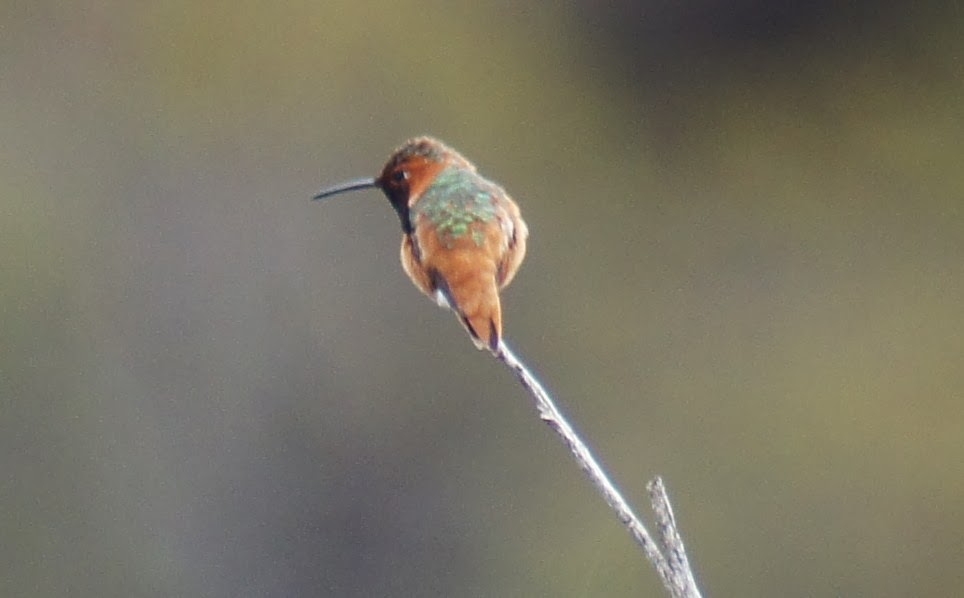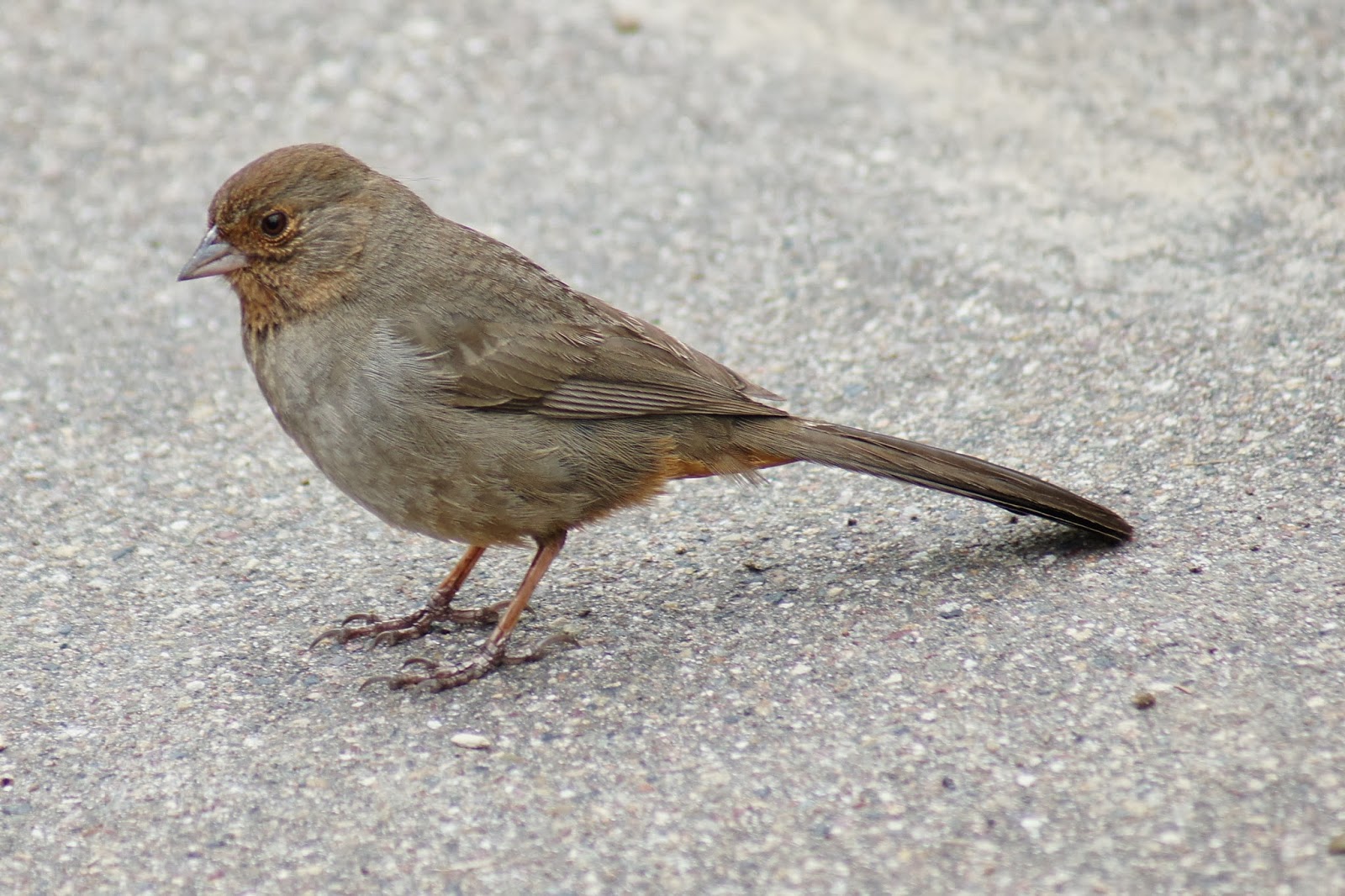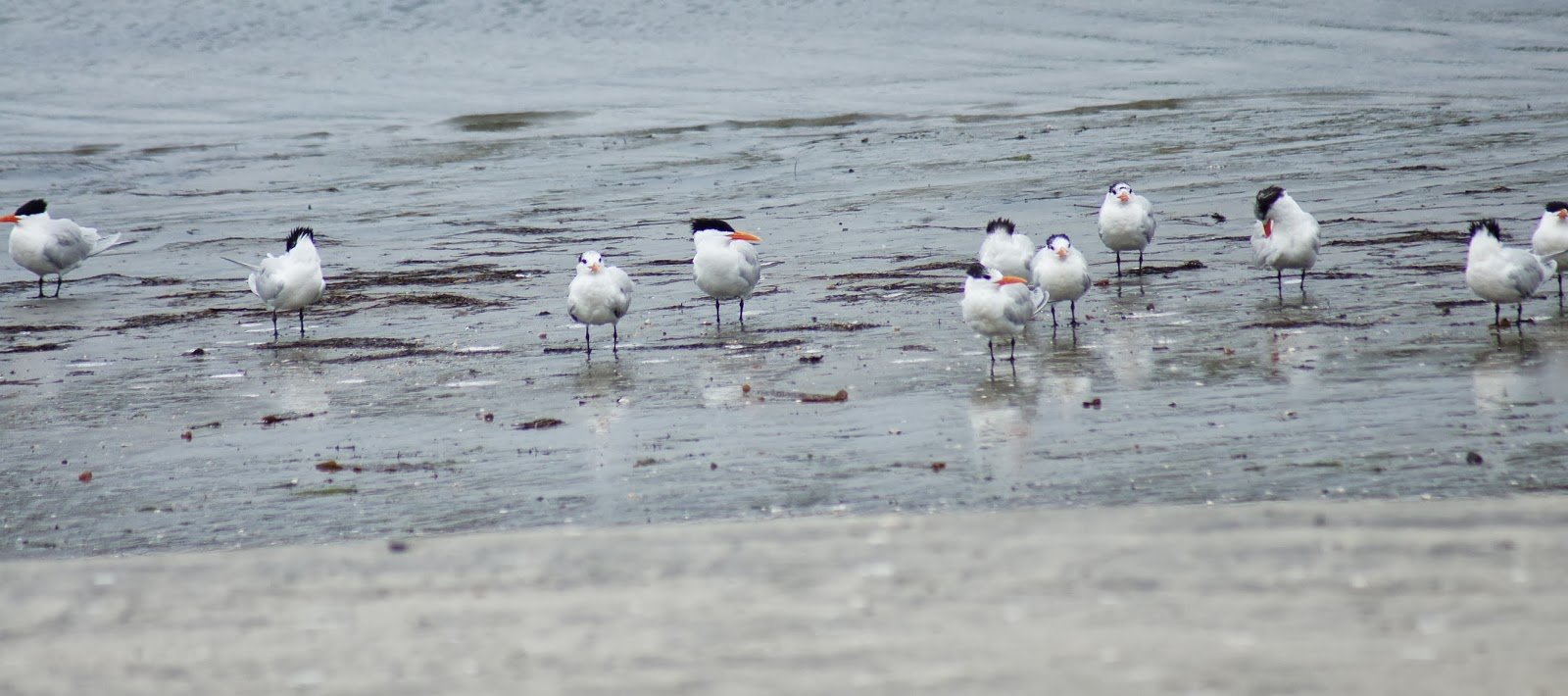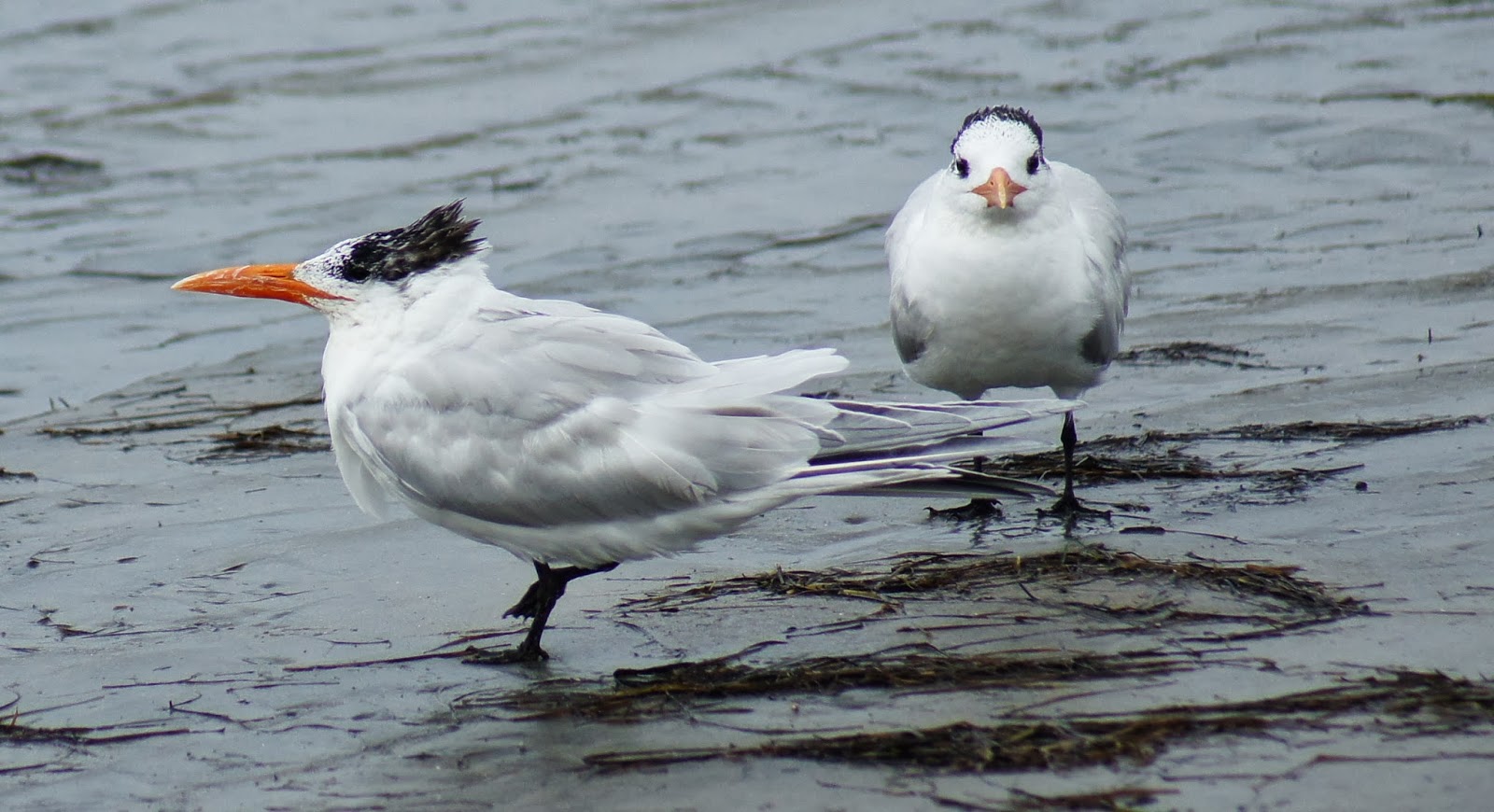Dominic and I were staying just north of San Diego, and had plans to bird much of the San Diego area, as well as bird other locations on the outskirts of San Diego. I haven't mentioned this yet, but San Diego has horrible traffic. It's such a busy city and place, I don't think you could ever safely throw a rock without hitting someone. Luckily, it's been a Saturday, so the traffic isn't as bad. After a rainy Friday, we woke up to a clear and sunny Saturday to start off. We immediately decided to go back to La Jolla Point, mainly in hopes of seeing distant pelagic birds from shore as well as a fun sea watch. After having very limited viability yesterday at sea, it was so nice to get out there to La Jolla Point today to have a chance at seeing distant sea birds.
La Jolla Point is a very popular San Diego destination for many birders, especially the locals who find these amazing seabirds. As Dominic and I arrived, we found many other birders and we lined up to search the sea. This included some of San Diego's best birders: Paul Lehman, Gary Nunn, and Guy McCaskie. I even ran into birding friend Michael Lester who I've birded with before in Arizona. Gary Nunn is another friend of mine and used to live in Arizona and I birded with him several times. Birding can be a very small world, that's for sure. It was a great time birding with all of these great people in San Diego. Paul Lehman helped Dominic and I out by giving us directions for many of our hopeful birds, which helped us greatly throughout the day (stay tuned...). For the next hour, the line of birders stared out at sea with our scopes, and we were hoping to get a sea bird. Luck soon hit as Paul said Black-vented Shearwaters were flying out in the distance. Dominic quickly got on them and let me look through the scope as they were flying south. Although distant, I was able to see this small shearwater clearly, who has very quick wingbeats. After I got the hang of the bird, I was able to find plenty of the Black-vented Shearwaters flying over the ocean on my own. The Black-vented Shearwater was my first lifebird of the day, but was also something else more important. It was my first ever pelagic bird, ever! I've always stared in my field guide and thought it was pathetic I didn't have a fulmar, jaeger, shearwater, storm-petrel, albatross, or auk. But today, that all changed with getting to see the Black-vented Shearwaters, about 35 of them in all throughout the morning. Because they were distant, I didn't even have a prayer of getting any sort of picture off of the shearwaters. With my pelagic trip getting canceled, I was very thankful to be able to see this bird from land. From land, we did see many good birds. Some of them included nice and close flybys of Pelagic Cormorants in flight.
And what's this bird, flyin' on in ;)
In the crowd of birders were two by the names of Matt and Justin, and they were on their way to look for a bird that Dominic and I were wanting to see, another potential lifer for me. It was the Nelson's Sparrow. Paul had given directions to us on finding the Nelson's Sparrow, and when Justin and Matt were leaving the Point, Paul told me that's were they were going and Paul suggested that Dominic and I should go quickly after them so we would have a better chance at the sparrows. The Nelson's Sparrows (3 of them) were found at San Elijo Lagoon north of San Diego, and were consistently frequenting the same location. When the tide would rise, the sparrows would also rise and would perch up in the open. Dominic and I decided to head to the Lagoon to look for the sparrows. The directions from Paul were easy and when Dominic and I arrived and looked down into the Lagoon, we could see Matt and Justin down by the spot.
As Dominic and I made our way down there and got closer to the spot, Matt and Justin were pointing down to the bushes they were behind. They were saying that the sparrow was right in front of them. Dominic and I soon got on the bird, even though it was obscured at first.
Besides the Nelson's Sparrows, there were other good birds to be seen at San Elijo Lagoon. Paul Lehman also suggested to us that we look for California Gnatcatcher there as well. The habitat on the other side of the Lagoon was perfect for the Gnatcatcher. During the search for the Gnatcatcher, we found some other good birds. One of them was this "Belding's" Savannah Sparrow.
As we continued along the trails looking for the Gnatcatcher, Dominic then spied my third lifer of the day. I was expecting this bird further into our trip, but not here and not today. It was an awesome way to get this lifer. The Allen's Hummingbird!
The Allen's Hummingbird is almost identical to the Rufous Hummingbird, only every male Allen's has green on his back, like this one photographed above. Another difference in the two species that really nails down the Allen's identification are the narrow outer tail feathers on the bird. It is a very difficult identification, and sadly, there are some green-backed Rufous Hummingbirds. This is less than 5 percent of the Rufous population. So, at this time of year in California, where Allen's is resident along coastal chaparral and it's too early for migrant Rufous Hummingbirds, our identification is lock down safe!
As we enjoyed the Allen's Hummingbird and searched for the California Gnatcatcher for nearly two hours without success, we decided to move on. Shy Wrentits were singing everywhere and were mostly out of sight, but several California Thrashers were singing out in the open, and they weren't so shy..
We then headed to Mission Trails Regional Park, south of San Elijo Lagoon and east of San Diego. This location is known to be a productive one for the California Gnatcatcher. When we got to Mission Trails Regional Park, we looked things over on a map and Dominic had received information from birder Diane Touret for a small location that she had found to be very productive for the California Gnatcatcher. This was only a fourth-of-a-mile down the street from the visitor center, and we gave it a shot. Diane had given us many awesome directions and tips for our trip prior to this excursion for the Gnatcatcher, and her streak of great advice continued. We weren't even walking for a minute until we heard a California Gnatcatcher calling by the side of the trail! The bird came into view very quickly, and we got to enjoy it up close. It was my fourth lifer of the day, and it was a great thrill to land it after striking out on it during a two hour search at our previous birding location. Gnatcatcha yo!
The California Gnatcatcher is endangered due to it's habitat loss in an expanding sea of invading people in California. It's habitat is crucial for it's survival, which is coastal chaparral and oak habitat.
We then hiked a mile long loop trail at the Mission Trails Regional Park. This park was very nice, but we were there rather late in the day for good avian activity and we had other places that we needed to bird.
This lone Golden-crowned Sparrow made the quietness a little more interesting. Surprisingly, this was only the second Golden-crowned Sparrow that we had during our trip.
As we were eating our lunch after the short hike in the Mission Trails Park parking lot, this California Towhee also wanted something to eat..
From Mission Trails Regional Park, we then headed back west into San Diego in pursuit of more great birds. Our first target was the Black Skimmer, which Paul Lehman told us could be found in certain places of Mission Bay. The Black Skimmer was another potential life bird for me, and I really wanted to see this odd but awesome bird and add it to my life list. At first, Dominic and I thought finding the Skimmer flock would be easy, but we had to put in a huge effort in order to see them. However, there were many good birds found throughout Mission Bay in San Diego, and it made the search more enjoyable. Now, Mission Bay is huge, and it really has an east side and a west side, both of which have extensive waters and beaches. We decided to cover the east side first. On one of the beaches that we first pulled up to, I quickly spied a resting flock of Royal Terns. This was going to be my first time of really getting to study this species up close!
In the Royal Tern flock, there were birds that were already in breeding plumage, and then others who hadn't come into breeding plumage yet. The Royal Tern sure is Royal, and very loud too. As I approached the flock, they gave very loud calls and some of them would kick up in flight. All terns are impressive to watch in flight.
It was really fun to have direct comparisons between the breeding plumaged Royal Terns and the non-breeding Royal Terns.
Mixed in with the Royal Tern flock was another Heerman's Gull. On this trip, if a Heerman's was around, I sure didn't pass up many photo opportunities. I'm sure Dominic got sick of me going after every single Heerman's Gull that I saw.
Also present were many Willets, and boy, they sure do look awesome in flight!
There were also many ducks on the extensive bay, and one of them was this rather distant drake Red-breasted Merganser. I've seen many Red-breasted Mergansers in Arizona during the winter, but all of them have been female plumaged birds. This was my first adult male. California, you are treating me well!
We then continued our search for the Skimmers after searching much of the east side of Mission Bay without success. It was then on to the west side. The birds were far more distant on the west side, and I carefully looked at each distant flock for any Skimmer-shaped bird life. After a big scan, I saw a flock of something that looked good for a Skimmer candidate. I scoped the birds and they really did look Skimmer shaped, and I knew that was the flock. The problem was, the were all the way on the very west side of Mission Bay, which would require a detour for Dominic and I in midst of a very crowded city. Have I talked about the San Diego traffic yet on these posts? Well, it's absolutely horrible. I love San Diego, but I would never want to live in it because of the horrible traffic. Back to the Skimmers, this was pretty much our view of them.
As we started the detour, we knew we were looking at the flock from very far away, and very far away just isn't good enough. We figured out that the Skimmers were on Ventura Cove, which was a mile away from us. Dominic and I slowly made our way over to the location....
As we arrived at Ventura Cove, we pulled up to the beach area. I was very thrilled when we came over the hill, and there was my life bird up close, the flock of the impressive Black Skimmer!
As I mentioned before, the Black Skimmer is a very bizarre and odd bird. It is a relative of terns, and it's upper mandible is much shorter than it's lower mandible. This gives the bird it's extra weird look, but it helps it capture it's prey that consists of fish. It prefers coastal sheltered waters throughout it's range, especially bays like Mission Bay. Over the next few minutes, I was able to get very close to this awesome bird!
Dominic snapped a memory shot of me with the Black Skimmer flock..
Even with all of the Black Skimmer excitement, there were other cool birds nearby on Ventura Cove also. This also included the sea goose known as the Brant. The Brant is a beautiful bird, and one I certainly haven't seen much of at all prior to this trip. During this trip and especially today, I have been able to see a lot of them.
Up next, Dominic and I headed back out to Mission Beach Park in search of another potential lifer for me in the form of another rocky shorebird...the Surfbird! They were reported at a specific rocky jetty that was at the south side of the park. When Dominic and I arrived, we ran into the same Justin and Matt from earlier in the day, and the four of us quickly found a few Surfbirds out in the jetty. Although distant, we could see them well. The Surfbirds were also joined by a few Black Turnstones and a Wandering Tattler. I managed to get a distant picture of the Surfbird to start things out.
And then with the waves rapidly coming in at times, the Surfbirds would fly closer. It got slightly better when the bigger waves would come into the rocky jetty. I guess most living creatures don't like to get soaked.
We all then tried something new to get closer to the Surfbirds. We decided to pull a Sanderling. For those who don't know about the Sanderling, it's another shorebird that likes to feed on prey that gets washed up from the tide. When the waves go back down from shore, the Sanderling runs out and feeds as much as it can before the waves come back in. When the tide then comes up, the Sanderling runs up the shore as fast as it can to avoid getting wet. It is hilarious to watch, especially when there are a lot of Sanderlings in one flock. We decided to do that in order to get closer to the Surfbirds. When the waves went down, we would run out to take pictures of the Surfbird, and when the would come back in, we would run back out.
This resulted in better views of my life bird. I also reached a nice number for my life list with this bird, number 450! Every 50 is one to celebrate in my opinion as the life list gets higher, and this bird was certainly a great bird to reach that number with.
Other birds along this beach included a curious American Pipit and a cooperative and up close Willet.
Following Mission Beach Park and it's Surfbirds and numerous surfers out on the water, Dominic and I were on one more mission for the day. It was a different one than I would have expected for this trip, but it was a cool one to close out an awesome day. We were on an eastern warbler chase, and it was a Bay-breasted Warbler that is being seen at 4510 Executive Drive in La Jolla. This was another life bird for me, and Dominic and I quickly found the wintering eastern warbler within minutes of pulling up to the spot, which was a business area building with many large trees in front of it. For being in non-breeding plumage, the Bay-breasted Warbler was actually a pretty good looking bird!
The Bay-breasted Warbler was my seventh lifer of the day! Getting seven lifers in a day is a rare thing for me now, and my life bird count for the trip is now up to 18 birds! I saw 6 the first day, 5 the second, and 7 on the third. For a recap of today, the seven lifers were Black-vented Shearwater, Nelson's Sparrow, Allen's Hummingbird, California Gnatcatcher, Black Skimmer, Surfbird, and Bay-breasted Warbler. It was so far our most diverse day of the trip, with nearly 90 species recorded. We also experienced birding in many different SoCal habitats, hung out with some very famous birders, and even went on an eastern rarity chase. What a memorable day it was. To close out the day and to celebrate me getting my 450th bird, Dominic kindly treated me to a Swordfish dinner at a very nice restaurant north of San Diego.














































.jpg)





.jpg)






Pretty exciting stuff Tommy! California is SOOOO close and definitely calls for more trips this year. I could not believe some of the birds we spotted up close. We were able to get close to Marbled Godwits on the beach. Here in AZ.....I'm lucky if I'm in a half mile distance from them:) Congrats!
ReplyDelete